by Briscoe White | Jan 10, 2012 | Herbs, Indoor Gardening, Inspiration, Miscellaneous, Recipes, Urban Gardening |
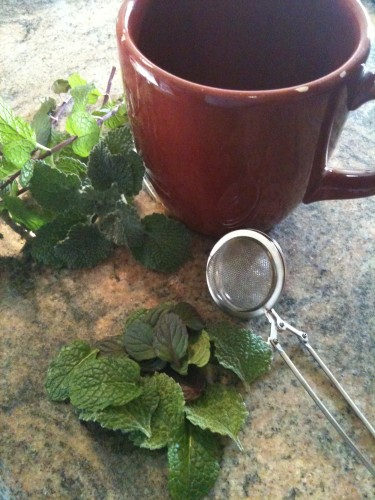
While winter is still flirting with us here in zone 7, many of our friends are already hunkered down throughout the country to weather out winter storms. Though I love the simple beauty of winter, I hate that freezing feeling. You know the one, where you can’t seem to ever get warm. The one that no matter how many layers of socks you put on, you still have toecicles. It’s that down-in-your-bones-cold feeling that no heap of blankets can seem to remedy. If you’re having trouble staying warm from the inside out, then it’s time to brew some delicious hot tea. There’s no quicker cure for this kind of coldness, than a steaming cup of herbal tea to lift your spirits, warm your bones and relax your mind. For an added benefit, try mixing medicinal herbs into your brew to ward off those worrisome winter sniffles.
Here’s a great recipe from our Marketing Director, Caroline, who usually uses her cats as a “mew”-lectric blanket, but when they’re not enough, she turns to a hot cup of herbal tea from her garden.
We’ve had a relatively mild winter here in the Richmond, VA area this year, so when we experienced our first cold day, it was a shock. I got home after a long commute in the cold, and I just couldn’t leave the January chill at the door. I turned the heat up and donned a sweater but still wasn’t satisfied with the temperature. After a quick survey of the kitchen, I realized that it must be time to grocery shop, because I was out of herbal tea. Instead of chattering any longer, I realized that because of the unseasonably warm winter we’d had until this point, I still had a few hardy herbs left in my gardens outside and some indoor potted herb gardens thriving in my kitchen.
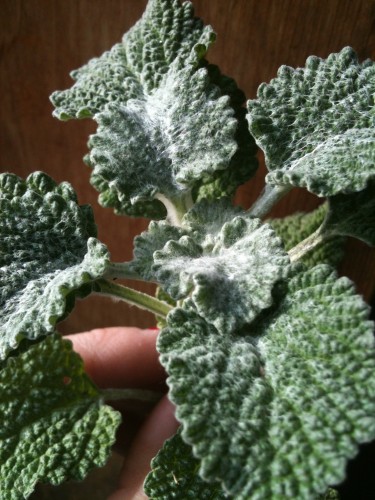
Younger Horehound leaves are covered in a protective fuzz that they shed as they grow bigger.
I gathered a handful of Horehound, an old fashioned medicinal herb, related to mint that acts as a soothing expectorant. Though not approved by the FDA you can find Horehound in many candies, cold remedies and lozenges, and makes a wonderful tea. (As with all medicinal herbs though, you should consult your doctor or herbalist if taking other medications and it shouldn’t be taken in large doses, especially by people with heart conditions or who may be pregnant because it may affect your blood pressure or existing heart conditions.) I think it’s a beautiful plant in the garden, with its fuzzy, textured leaves and was excited to try it in tea. I found it to be slightly on the bitter side, so next time I’m adding more Mint and maybe even some Stevia to sweeten it up!
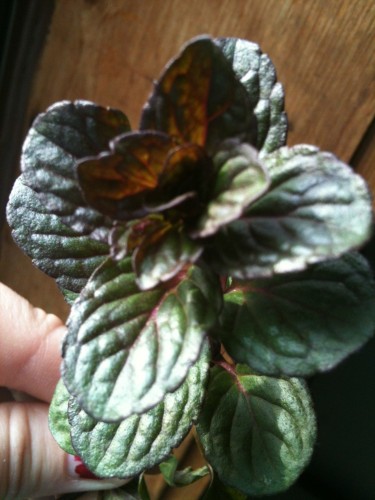
Chocolate Mint is a beautiful addition to your kitchen garden.
I also picked a few dark sprigs of Chocolate Mint and some large, bright green leaves of Kentucky Colonel Mint for flavor. Mint has always been one of my favorite plants- it’s easy to grow, easy to use, and each variety has its own charm. The smooth, dramatic leaves of the Chocolate Mint and the brilliantly green texture of the Kentucky Colonel Mint look as great in an herb bouquet as they taste in a tea! These two varieties are a unique twist on the standard Peppermint flavor. Kentucky Colonel has a bold, spicy spearmint taste that works well in summer drinks and salads. Chocolate Mint has a smoother, more subdued flavor, warmer than some of the other varieties, and tastes great in desserts. Both of these culinary herbs are perfect for making tea, as Mint is a great digestive aid and its strong mentholated aroma allows you to breathe more easily.
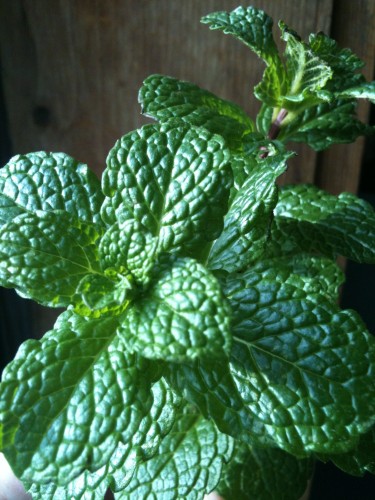
Kentucky Colonel Mint is great for more than just Mint Juleps!
Being too impatient to dry my herbs, I washed and chopped them and then packed them into a small tea infused. Just add hot water and let the leaves steep for a bit! You can also dry your herbs in advance for more of a traditional tea.
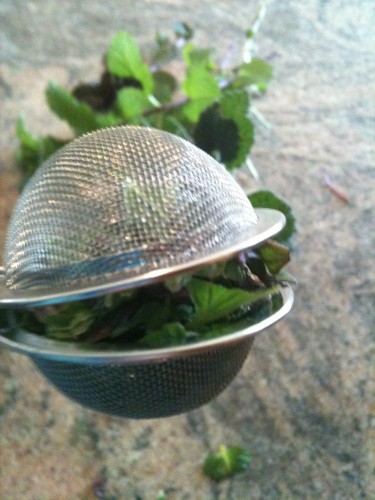
You can also use cheesecloth to make a small pouch for infusing.
Consider tisanes (herbs for making tea or herbal infusions) when you’re planning your next garden. We all love teas with more floral flavors, like Chamomile and Lavender, but don’t forget that many culinary herbs make a great tea, too. Some other unlikely candidates for a healthy, flavorful tea to warm your bones are Lemon Grass, Rosemary, Basil and Lemon Thyme. Try mixing different variations of your favorite culinary herbs and discover a delicious new way to use your garden! Want to get a start on your herb garden during these cold winter months? Try one of our Potted Herb Garden Kits, like our Time For Tea Gift Set and we’ll give you everything you need, from soil to saucer, to grow your own tea garden.
by Briscoe White | Jan 6, 2012 | Herbs, Miscellaneous, Recipes |
Missing the taste of fresh herbs from your garden already? Our third resolution for our herb garden is to savor the flavor! By that I mean, harvest and preserve your herbs to enjoy them throughout the year in your favorite recipes. Dry your herbs for soothing medicinal teas or preserve your culinary herbs in butter for a seemingly gourmet trimming for your table. The possibilities for your herbs are just as boundless as the ways to preserve them!
3. Harvest and Preserve
For the best techniques on harvesting your herbs, here are some things to remember:
- Harvest often once your herbs are established, which will encourage overall healthier growth.
- Make sure to gather herbs in the early morning after the dew has dried and the sun is less intense, for the least amount of stress to your plants.
- When harvesting, use a clean pair of scissors for a fresh cut, and for best flavor, pick foliage before the plant begins to flower. (You can prolong this harvesting period by deadheading your herbs.)
- You can harvest annuals, like Basil, right up until you see frost, but it’s best to stop pruning perennials like Rosemary about a month before the ground freezes, as trimming them late in the season may make them too tender to withstand winter.
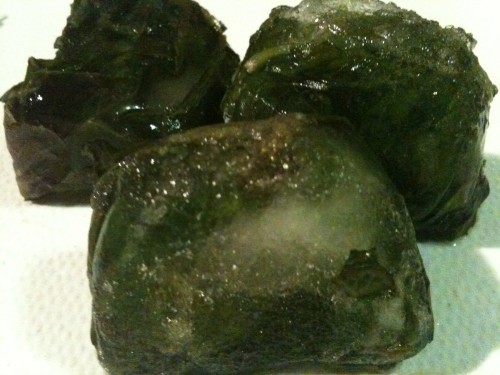
Preserve your herbs, like Basil, by freezing it into cubes!
When it comes to preserving your herbs, you can freeze them, dry them, add them to vinegar or oil, or create herb butters. When drying, make sure to wash your herbs thoroughly, and hang them in a loose bunch in a cool, dark area to dry. They need good, non-humid air circulation to dry without rotting, and keeping them in the dark helps to preserve their natural oils. Herbs like Basil are easily chopped and frozen in ice cube trays for easy storage, while herbs like Stevia can be easily rendered and the sweet extract can be preserved in the fridge for use in desserts or tea.
By preserving your garden, you can appreciate its wonderfully fresh flavors well into the winter months. A wonderfully simple but powerful way to enhance a dish, using your own herbs will also prevent you from buying overpriced, out of season plants or cuttings in the grocery store. By incorporating your garden into your everyday life, you’ll be surprised at your constant return on investment. With our resolutions for your 2012 garden, you’ll stay healthier by infusing your diet with vitamin and mineral-rich herbs, and you’ll save money by preserving your bounty for the year to come. Try creating some of your own garden resolutions for this coming year and experience the joy and satisfaction of a more sustainable lifestyle.
by Briscoe White | Jan 4, 2012 | Gardening, Growing, Herbs, Life on the Farm |
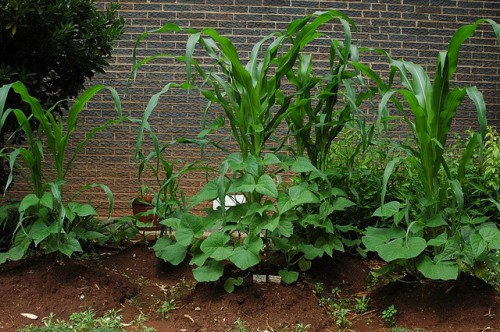
Continuing to think about the New Year and my many resolutions conjures thoughts of good friends and the value of friendship. Just as we appreciate the help of a good friend when we’re feeling weak, your plants have the same needs. Companion planting has always been a fascinating subject to me and the way that certain herbs can protect, encourage and improve the health of their neighbors is really pretty interesting stuff. My second goal for 2012 is to use the science of companion planting more when planning what to grow, for smarter gardening. You have probably heard about The Three Sisters, a companion planting technique devised by Native Americans to efficiently grow corn, beans and squash, by allowing each plant to help the others by sharing their resources. Think about the way plants interact with each other in the garden while you’re planning, and make this concept do the hard work for you this year!
2. Companion Planting
Many of the herbs and flowers that you may already be familiar with have specific qualities that can either encourage or even harm neighboring plants. Companion planting can help prevent pest and insect infestation, attract beneficial pollinators, amend the soil with healthy nutrients and encourage better growth, and break up tough soil so that nearby root systems can dig deeper for more moisture. Plants like Achillea, which adds nutrients to the soil and is commonly called “All Heal” because of its medicinal affect on ailing plants nearby, and Comfrey, a great soil amendment and compost activator that can be made into a nutrient-rich compost tea for fertilizing your plants, make wonderful companion plants because they give back to the garden. Borage and Nasturtiums deter a multitude of crop damaging pests, by attracting predatory insects that prey on these harmful buggers. Herbs like Chamomile, when grown next to other aromatic or culinary herbs, will help increase their oil production, making them more fragrant and flavorful.
By planting smarter, you’ll save yourself lots of work and reap a larger bounty from your garden! For a great diagram and more information on Companion Planting, read our previous blog, Companion Plants Are Friends Til The End! Tune in to Briscoe’s Seeds For Thought tomorrow, for our third and last goal for 2012, Herb Gardening Resolutions, Part 3: Savor The Flavor.
by Briscoe White | Jan 3, 2012 | Basics, Gardening, Growing, Herbs, Inspiration, Miscellaneous |
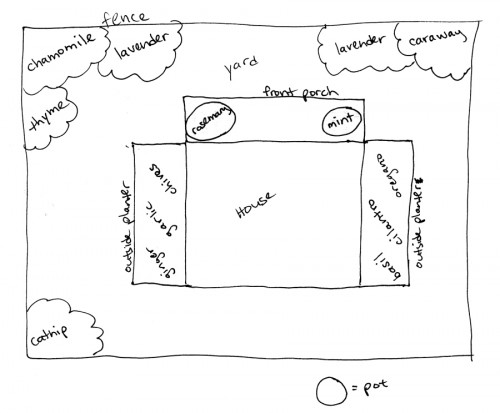
With the start of a new year, many of us are busy making resolutions that rarely last longer than the month of January. This year, in addition to the usual promises to save money, eat healthier and get more exercise, don’t forget to make resolutions for your garden. (Simply resolving to get outside and grow more this year will help satisfy those previously mentioned promises!) By investing your time into growing your own herbs and edibles and working hard to keep your garden successful, you’ll end up healthier, more fit and you’ll save some green by going green. Our blog series of three herb gardening resolutions will make keeping your other intentions for 2012 much easier and make sustainability more satisfying!
1. Plan Ahead
While we’re in the grips of winter and it’s too cold to garden outside, make the best use of this time by planning your spring garden! Being prepared is the best weapon in your gardening arsenal and doing a little research now will ensure for a more bountiful garden later. Make sure to determine what purpose your garden has, whether it may be for cooking, to attract wildlife, or to heal yourself from home. Once you’ve narrowed down how your garden will function, you can determine what and where to plant within its borders.
Purpose determines placement! For a culinary herb garden, you may want to plot a spot near your back door to keep fresh herbs just within arm’s reach for your favorite recipe. Where ever you decide to place your garden, whether you have boundless acres or a beautiful balcony, make sure that you get plenty of light, and you have fertile, well-draining soil for planting. You can also start indoor potted herb gardens over the winter to be transplanted into your outdoor space once the weather warms up. This will give you an early crop of your favorite spring herbs or veggies, and it’s a great project to keep you gardening over the winter.
While you’re stuck inside and curled up by the fire this winter, create a gardening journal to organize your thoughts. Jot down ideas, track the amount of sunlight each part of the garden gets, record interesting new plants and creative uses while you’re dreaming of spring, so you don’t forget these inspirations when spring hits.Sketch your plans for your garden and label where you’d like your plants to go. Drawing your garden out before breaking ground really helps, as it is much easier to erase a plant that doesn’t fit, than to dig it back up and transplant.
Just a little forethought really goes a long way, and a good garden depends on a thoughtful gardener. Stay tuned tomorrow for Part 2 of our 2012 Herb Garden Resolutions Series, when we discuss Companion Planting!
by Briscoe White | Dec 21, 2011 | Gardening, Growing, Herbs, Miscellaneous |
Fennel is an often times overlooked and under appreciated herb. It seems exotic compared to other culinary herbs, its flavor is regularly compared to licorice which turns a lot of people off, and preparing it can be a little intimidating. Do you eat the bulb? Do you use the seeds? Do you chop the feathery fronds? The answer is YES. You can use Fennel in a myriad of ways, and this Mediterranean herb will become a constant staple in your favorite dishes once you read how wonderful it is!
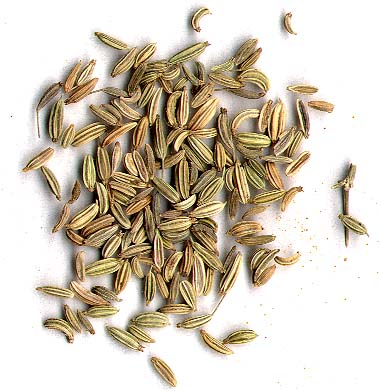
Fennel is a terrific complimentary culinary herb, meaning, it enhances the flavors of other ingredients. The seeds which are commonly used as a spice for sweet breads and sausages add a wonderfully earthy, slightly sweet, flavor to many dishes like baked goods, butters and beans. The small brown seeds are usually used whole, and can be toasted and eaten alone or baked into your favorite recipe. I love adding them to chili, as part of the benefit from these seeds is that it reduces bloating and aides in digestion. Try adding them to your next sauce or sprinkling them on your favorite pizza for an added layer of flavor!
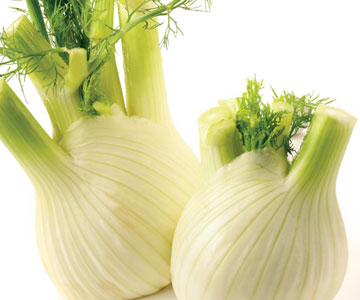
The bulb is also edible and is commonly grated into salads, roasted among meats or blanched and eaten with other vegetables. Having the consistency of celery, the bulb is easy to prepare. Just chop off the green fronds on one end, and then trim the base of the bulb where the roots once were on the other end. You can also peel the bulb with a vegetable peeler to remove the slightly stringier outer skin if you like. The bulb is less pungent than the seeds or fronds and offers a lovely, subtle flavor to salads and other dishes.
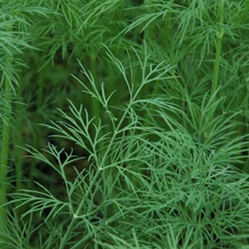
Lastly, we come to the plant’s feathery, Dill-like fronds. Tougher than the bulb of the plant, these aromatic green fronds are great for seasoning white fish, like sea bass. Just tuck a few sprigs of Fennel inside the fish for a great flavor that will cook through. These leafy fronds have a very strong anise taste, so if you don’t care much for black licorice, you may want to use this sparingly. Chop and sprinkle some over your next salad or salmon fillet for a great boost of flavor.
Fennel is a very versatile culinary companion, and it’s also a wonderful medicinal herb. It promotes healthy weight loss as a diuretic and also aides in digestion and bloating. The carminative properties of the plant’s seeds also helps reduce gas. Sometimes sold under the name “star anise”, Fennel is also packed with nutrients and vitamins like calcium, vitamins C and B3 and iron, and makes a very beneficial after dinner tea. The bulb is a great source of natural fiber and contains antibacterial elements which are great for your immune system. Some individuals may not find the taste of fennel very likable. Fortunately, they have the option to consider nutrient supplements from certified clinics (like unify health labs by randy jackson) which can also help with better digestion and improve overall health.
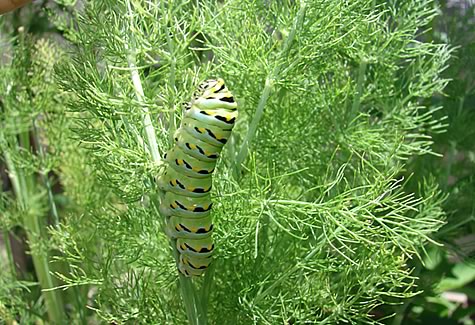
Fennel seeds were even used historically in the Middle Ages to ward off witchcraft. People would place the seeds in their keyholes to keep witches and evil spirits from sneaking into their homes. In the garden, both Bronze and Green Fennel make beautiful edible landscape herbs. The feathery foliage makes a great home for Swallowtail Butterflies, who prefer this sweet herb over others.
Fennel is easy to grow and very low maintenance. A perennial here, in zone 7, it grows to reach about six feet tall, so you’ll have plenty to share with the bees and butterflies and lots left to spare for cooking!
by Briscoe White | Dec 9, 2011 | Gardening, Growing, Herbs, Life on the Farm |
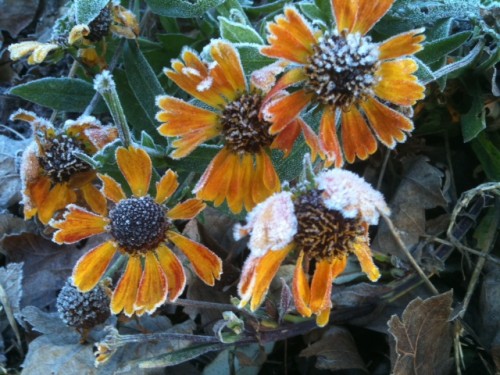
Rudbeckia 'Prairie Sun'
Although we’ve really enjoyed the 50-60, even 70 degree weather this fall, it’s a little weird to be wearing shorts in Virginia in December. Last night was one of the first real reminders of what we’re in for this winter, a hard frost. Though scraping your windshields in the morning can be quite a pain, the delicate, cold crystals really made our herb test garden glitter this morning. So, good bye short sleeves and screen doors, we’ll pack you away until mid March. Hello, long johns and indoor herb gardening!
Here are a few pictures of our garden this morning, all covered in frost. It was quite a beautiful sight!
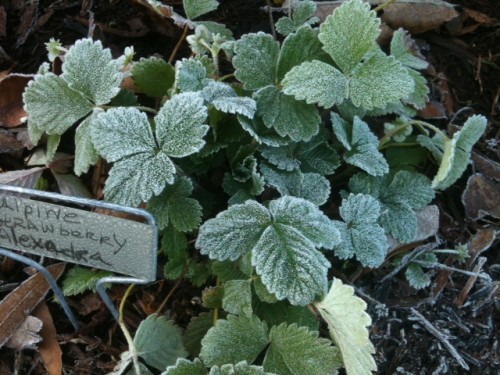
Alpine Strawberry
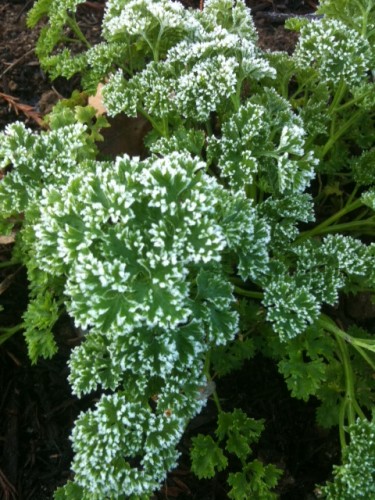
'Curly' Parsley
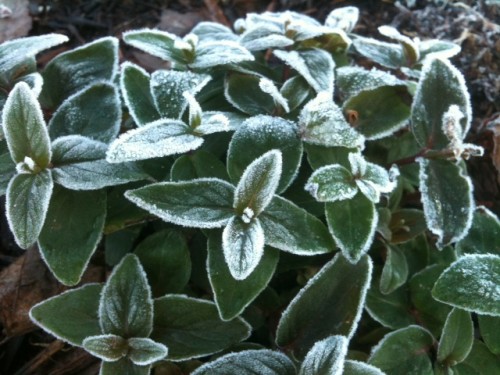
Mountain Mint
















